
Back Lineêr B Afrikaans نظام خطي ب Arabic Лінейнае пісьмо Б Byelorussian Линеар Б Bulgarian Lineal B Catalan Lineární písmo B Czech Линилле Б çырулăх CV Linear B Danish Linearschrift B German Γραμμική Β Greek
This article has problems which may render some text or images unreadable or difficult to read in dark mode. Desktop readers can switch to light mode temporarily using the eyeglasses icon at the top of the page. |
| Linear B | |
|---|---|
 | |
| Script type | with additional ideograms |
Time period | c. 1400–1200 BC |
| Status | Extinct |
| Direction | Left-to-right |
| Languages | Mycenaean Greek |
| Related scripts | |
Parent systems | Linear A
|
Sister systems | Cypro-Minoan syllabary |
| ISO 15924 | |
| ISO 15924 | Linb (401), Linear B |
| Unicode | |
Unicode alias | Linear B |
| |
Linear B is a syllabic script that was used for writing in Mycenaean Greek, the earliest attested form of the Greek language.[1] The script predates the Greek alphabet by several centuries, the earliest known examples dating to around 1400 BC.[2] It is adapted from the earlier Linear A, an undeciphered script perhaps used for writing the Minoan language, as is the later Cypriot syllabary, which also recorded Greek. Linear B, found mainly in the palace archives at Knossos, Kydonia,[3] Pylos, Thebes and Mycenae,[4] disappeared with the fall of Mycenaean civilization during the Late Bronze Age collapse. The succeeding period, known as the Greek Dark Ages, provides no evidence of the use of writing.
Linear B was deciphered in 1952 by English architect and self-taught linguist Michael Ventris[5] based on the research of American classicist Alice Kober.[6] It is the only Bronze Age Aegean script to have been deciphered, with Linear A, Cypro-Minoan, and Cretan hieroglyphic remaining unreadable.[7]
Linear B consists of around 87 syllabic signs and over 100 ideographic signs. These ideograms or "signifying" signs symbolize objects or commodities. They have no phonetic value and are never used as word signs in writing a sentence.
The application of Linear B texts appear to have been mostly confined to administrative contexts, mainly at Mycenaean palatial sites.[8] In the handwriting of all the thousands of clay tablets, a relatively small number of scribes have been detected: 45 in Pylos (west coast of the Peloponnese, in Southern Greece) and 66 in Knossos (Crete). The use of Linear B signs on trade objects like amphora was more widespread.[9] Once the palaces were destroyed, the script disappeared.[10]
- ^ "Palaeolexicon - Mycenaean Greek and Linear B". www.palaeolexicon.com. Retrieved 21 June 2024.
- ^ Professor Shelmerdine's Exciting Mycenaean Find, UT Austin Jun 2, 2011.
- ^ E. Hallager, M. Vlasakis, and B. P. Hallager, "The First Linear B Tablet(s) from Khania", Kadmos, 29 (1990). pp. 24–34
- ^ Wren, Linnea Holmer; Wren, David J.; Carter, Janine M. (1987). Perspectives on Western Art: Source Documents and Readings from the Ancient Near East Through the Middle Ages. Harper & Row. p. 55. ISBN 978-0-06-438942-6.
- ^ "Cracking the code: the decipherment of Linear B 60 years on". Faculty of Classics, University of Cambridge. 13 October 2012. Retrieved 31 May 2017.
- ^ Fox, Margalit (2013). The Riddle of the Labyrinth: The Quest to Crack an Ancient Code. Ecco Press (Harper Collins). ISBN 978-0-06222883-3.
- ^ Packard, David W. (1974). Minoan Linear A. Berkeley: University of California Press. ISBN 0-520-02580-6. OCLC 1055287.
- ^ [1]Bennet, John, "The structure of the Linear B administration at Knossos", American Journal of Archaeology 89.2, pp. 231-249, 1985
- ^ Hooker, J.T. (1980). Linear B: An Introduction. Bristol Classical Press UK. ISBN 978-0-906515-69-3.
- ^ Ventris and Chadwick 1973, p. 60.